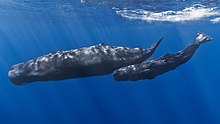Sperm whale
The sperm whale (Physeter catodon), also known as the cachalot, is the largest toothed whale. It has the biggest head of any animal. The head can be about 20 feet (6.1 m) long, and is about one-third of the whale's body. It also has biggest brain of any animal.[1] Its lower jaw is small and contains its huge, conical teeth. These teeth fit into sockets in the upper jaw.
| Sperm whale | |
|---|---|

| |
| A mother and baby Sperm whale | |

| |
| Size comparison against an average human | |
| Scientific classification | |
| Kingdom: | |
| Phylum: | |
| Class: | |
| Order: | |
| Suborder: | |
| Family: | |
| Genus: | Physeter
|
| Binomial name | |
| Physeter catodon Linnaeus, 1758
| |
Diet
changeSperm whales are carnivores (meat-eaters). They mostly hunt medium-sized squid. They also eat many kinds of fish such as skate. Sometimes they hunt giant squid that live on the ocean bottom at great depths. Most of the animals sperm whales eat live in the deep sea, and sperm whales dive very deep to hunt. They regularly dive between 300 and 800 meters (980 and 2,620 feet) deep,[2] and stay underwater for two hours.
Size
changeSperm whales can reach up to 20.7m long, and weigh up to 80,000kg.[3][4] In the past, there have been claims about whales that were as long as 24 meters, but these claims are not proven, and there is disagreement about whether they are true.[5][6]
Echolocation
changeLike other toothed whales, the sperm whale uses echolocation, a way of sensing in which the whale makes a high-piched clicking sound and listens to the echoes that it makes as it bounces off of objects (like prey). Sperm whales use this to hunt, but also to communicate, using patterns of clicks called click codas. Sperm whales have special organs that they use for echolocation. These are called the spermaceti organ and the junk. The spermaceti organ is like a large barrel full of spermaceti, an oily liquid that sperm whales use for echolocation. The junk is made of cartilage and spermaceti, and is used to focus the sounds made for echolocation.[7]
References
change- ↑ "Brains". American Museum of Natural History.
- ↑ Whitehead, Hal (2003). Sperm whales: social evolution in the ocean. Chicago London: University of Chicago Press. ISBN 978-0-226-89518-5.
- ↑ Wood, Gerald (1983). The Guinness Book of Animal Facts and Feats. Guinness Superlatives. ISBN 978-0-85112-235-9.
- ↑ Carwardine, Mark (2008). Animal Records. New York: Sterling. ISBN 9781402756238.
- ↑ Ellis, Richard (2011). The Great Sperm Whale: A Natural History of the Ocean's Most Magnificent and Mysterious Creature. Zoology. Vol. 179. USA: University Press of Kansas. p. 432. ISBN 978-0-7006-1772-2. Zbl 0945.14001.
- ↑ McClain CR, Balk MA, Benfield MC, Branch TA, Chen C, Cosgrove J, Dove ADM, Gaskins LC, Helm RR, Hochberg FG, Lee FB, Marshall A, McMurray SE, Schanche C, Stone SN, Thaler AD. 2015. Sizing ocean giants: patterns of intraspecific size variation in marine megafauna. PeerJ 3:e715 https://doi.org/10.7717/peerj.715
- ↑ Mackay, R. Stuart (1980), "A Theory of the Spermaceti Organ in Sperm Whale Sound Production", Animal Sonar Systems, Boston, MA: Springer US, pp. 937–940, ISBN 978-1-4684-7256-1, retrieved 2024-11-17